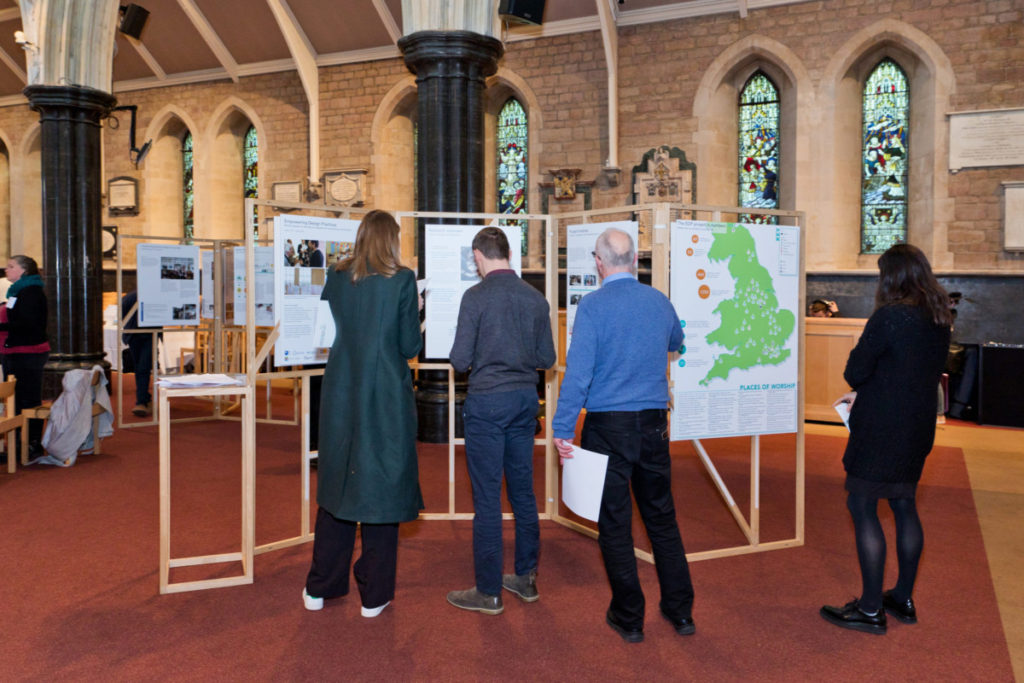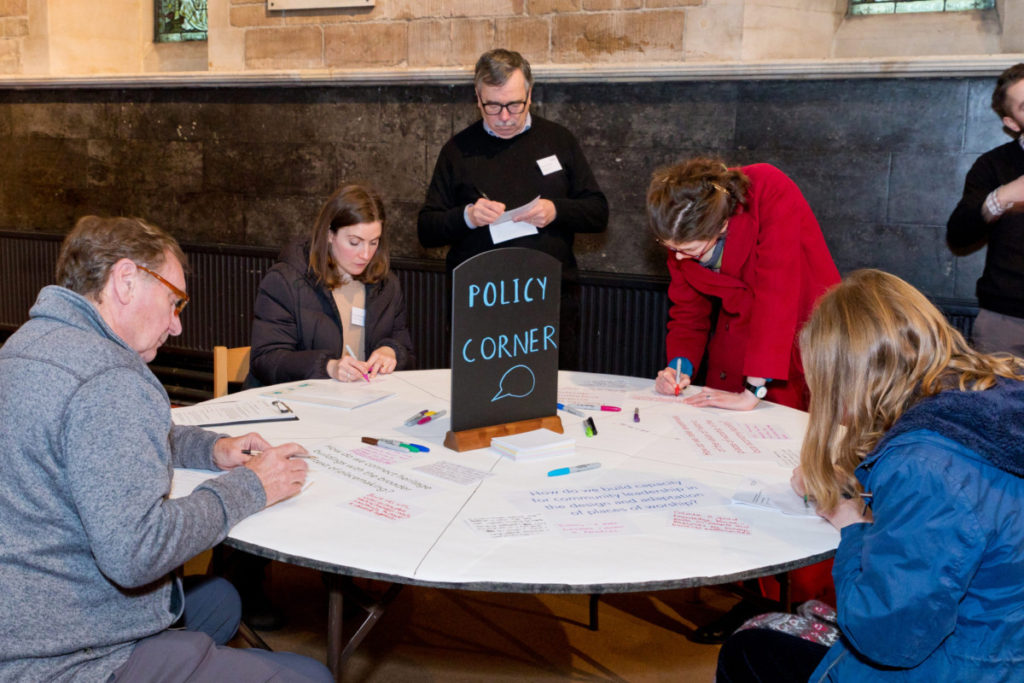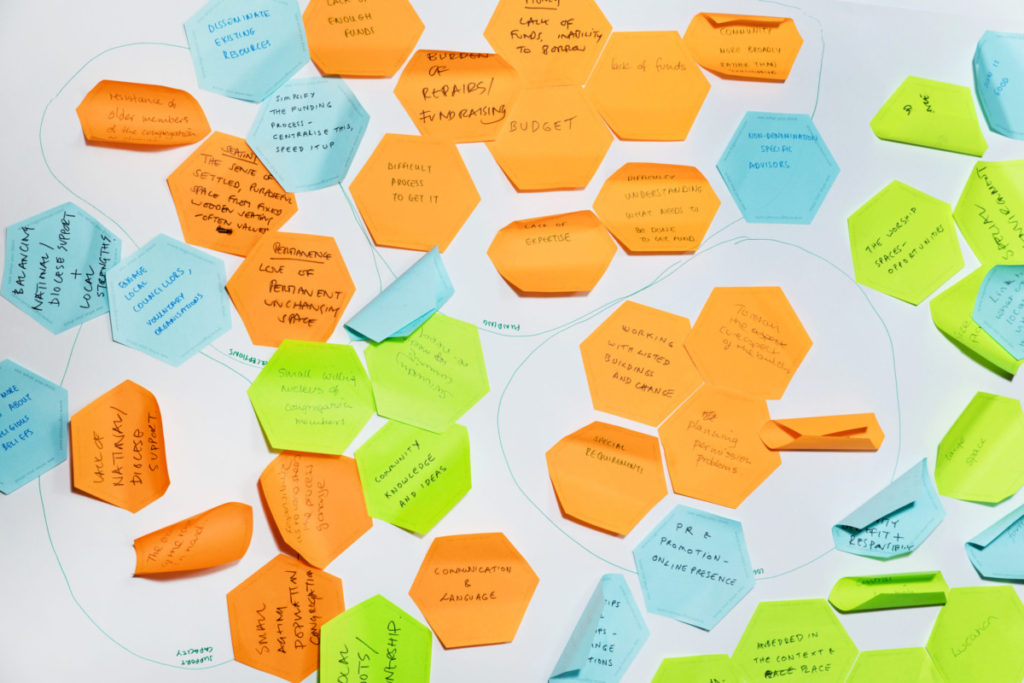Written by:
By Sophia de Sousa and Katerina Alexiou
On 12 February, 2020, The Empowering Design Practices research team gathered with partners and community collaborators, colleagues, funders and friends to celebrate five years of research exploring community leadership in design within the context of historic places of worship. This was a day to share learning and the resources produced by the research team, to celebrate community achievements and to explore the potential, opportunities and challenges that these buildings, and their custodians, face in providing welcoming spaces for their whole community.


The project’s celebratory conference and exhibition, Empowering Design Practices LIVE was held at St Paul’s Church in Hammersmith, a wonderful example of a church that has reinvented itself and transformed its building and offer to the community. The event was a wonderful opportunity to bring together the wide range of people and organisations that engaged with the project to reflect on work we have done together and to generate ideas and propositions for the future.


The day kicked off with an overview of the project and our key learning points and recommendations, based on our experience of collaborating with over 50 places of worship around the country, as well as professionals and support bodies that work with them. This was a moment to reflect on the specialness of historic places of worship as buildings, and on the custodians tasked with looking after and unleashing the potential in these buildings. Through a design lens, we explored how community leadership, partnership working and effective community engagement can help ensure the long-term sustainability of these buildings, and help support local networks, community development and the life and vibrancy of these much-valued sacred heritage buildings.
The morning also included a panel discussion of various partners briefly sharing their key reflections and learning points, from the perspective of the organisations and sectors they represent. A key message that came through, articulated brilliantly by Historic England’s Head of Places of Worship and Owners Advice, Diana Evans, was that engagement in design is important, it requires support and capacity building, but it can also be great fun, a space to build confidence and a frame in which important connections, friendships and partnerships can be formed.
The rest of the day included both panel discussions and interactive workshop sessions.


Invited speakers
Our first panel of invited speakers was made up of representatives of community-led design projects at various points on their journey. Revd Canon Caroline Dick and Churchwarden David Wilcox from St Michael and All Angels, Witton Gilbert spoke about their Breathing Space project, and the importance of a vision being greater than simply the reordering of the church. They stressed the importance of talking to people, and bringing them with you on a journey to which each person and organisation can contribute in their own way.
Revd Simon Lockett from St Peter’s Church, Peterchurch spoke of the need to form partnerships, and the importance of being willing to experiment and if necessary, to change direction of travel in response to changing circumstances. He stressed the importance of high quality and values-driven design, and that this can be achieved with varying budgets.
Revd Geoffrey Eze from All Saints Church, Hanley spoke of the creation of a new enclosed space within their church, and the importance of changes to a building being catalytic, enabling new partnerships and new ways to serve the community as well as the congregation.
And finally, Adam Yusuf, Chair of Israac Somali Community Association in Sheffield, spoke of the group’s collaboration with the EDP research project, and with The University of Sheffield. These helped grow the e group’s awareness and appreciation for their building as an entity with its own history and identity, and realise the role that design can play in creating opportunities for the building to serve their community objectives. He also spoke of the importance of connecting with other groups taking on similar projects to transform their buildings, and how much they could learn from each other.


Our panel of professional speakers was tasked with presenting brief provocations from the perspective of an architect, a support officer and a researcher, which then led us into a plenary discussion with the room.
Some challenging questions and propositions were put to the room. Aidan Potter, Partner at John McAslan Architects quoted Jane Jacobs’ famous words, “Old buildings need new ideas” and challenged the room to be bold in our thinking about what is possible in places of worship. He also reminded us that the design for these buildings has to be a collective endeavour, with the architect simply one element of a complex and collaborative design process. Architect and researcher Nevine Nasser spoke of the relationship between sacred space and sacred experience, and reminded us that faith buildings must integrate into the society that surrounds them. Perhaps the most challenging provocation came from Wendy Coombey, Community Partnership & Development Officer at the Diocese of Hereford, who reminded us that these buildings must be at the service of people, and not the other way around. She asked what would happen if the custodians of these complex listed buildings facing the challenge of innovation and sustainability, simply decided to give the buildings back and opt for alternative spaces to gather and worship.


The EDP Live Exhibition
The exhibition offered a snapshot of the project, with key information and statistics about the activities and groups with which we have collaborated. It also included a section which introduced the wide spectrum of practical resources developed throughout the project and artefacts from public engagement activities and live student projects. The resources on offer for people to explore and take away included interactive websites Explore Design: community buildings, A Design Thinking Guide, as well as freely downloadable materials such as our Design Project Stories and our series of Designing Places with People booklets, on engaging communities in the design process. The exhibition also introduced emerging resources on working with architects, key topics for consideration when setting off on a project to transform a place of worship, and an online course on community leadership in design.


We also shared a series of films produced within the project, which include inspiring stories of community engagement in design, a practical resource on using digital media as a design engagement tool, and films capturing our Design Training, a workshop on developing a shared purpose, and related projects Prototyping Utopias and Tate Exchange.

Finally, the exhibition space included a policy corner which invited participants to record thoughts and recommendations about four key questions. Here is a small taster of the ideas that emerged:
How do we connect heritage buildings with the broader context of placemaking?
- Build links with wider, existing place making strategies locally and nationally to create a cohesive approach.
- Identify within local planning policy that S106 (CIL) can go towards the reuse of heritage buildings for community/ services/ etc.
How do we champion and enable community engagement in design decision-making?
- By showing the local community that changing our buildings will lead to more meaningful resources for the community.
- By funders encouraging this approach as a precursor to investment, to secure more sustainable projects.
- A release of funds for project development?
- By ensuring that they are engaged in the process from the start and listening to them. Solutions shouldn’t be imposed in a top-down approach.
How do we raise awareness of the value of historic places of worship in the local economy/ society?
- Collect feedback from community users and congregations, encourage councils to read it!
- By not holding up historic places simply as places of beauty but also as useful spaces that can benefit the local community.
How do we build capacity for community leadership in the design and adaptation of places of worship?
- Partnerships with local government and councils for voluntary services.
- Training faith leaders. Central web-based resources, including a list of faith leaders willing to advise others.
- If owners + funders realised a vital first step was capacity building (if assets are to be protected) they would prioritise this
Workshops
The event offered opportunities for people to engage practically with some of the project’s methods aiming to facilitate collaborative exploration of issues and ideas and the generation of ideas for future actions.


The first workshop of the day (which ran in parallel to the community presentations) brought people together to explore the challenges, assets and opportunities that arise in the efforts to unlock and enhance the potential of historic religious buildings as places of community value. Participants worked in groups to map and connect their ideas about the barriers they face, but also the assets they have (their skills, resources, support) and to collectively come up with suggestions for future actions or processes. Here are some of their suggestions:
- Feeding grassroots knowledge (and longevity and connections) of faith buildings to governance – spreading awareness of Taylor Report
- Creatively connecting communities to construct and share knowledge and ownership
- Investigate partnerships with local agencies, local councillors, voluntary organisations, local groups and local activities
- Build networks
- Challenge the church establishment to be more radical about what churches can be


The final activity of the day brought everybody together to co-create ideas for possible future collaborations, actions, projects or networks. This ‘cross-pollination’ workshop focused in particular on exploring ways to enable custodians of places of worship to shape the future of their buildings, and the suggestions generated during the morning workshop were brought to bear on people’s thinking. Participants put on the table their resources, current projects and aspirations and explored synergies, connections and new ideas. A champion from each table then moved around to other tables to pitch their ideas and garner further support. At the end of a long day, it was heartening to see the unwilting enthusiasm with which everyone continued to share their knowledge, experience and goodwill to help build capacity in community-led design and support and strengthen communities around historic places of worship.
We’d like to thank everyone who attended the day, and shared their stories, reflections and ideas for the future. It is clear that there was fantastic energy and momentum in the room, and that there is much we can do together looking forward.
Sophia de Sousa is the Chief Executive of The Glass-House Community Led Design. Katerina Alexiou is a Senior Lecturer in Design at the Open University. Photos by Jonny Bowsworth.

